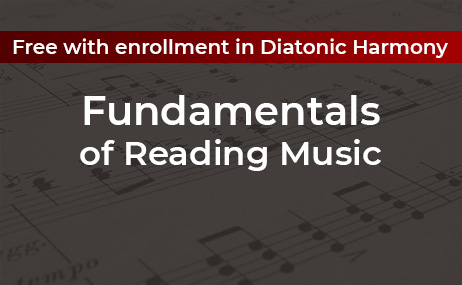Black Friday – 15% off single courses, 20-25% off bundles!
Excludes launch sales. Black Friday Sale ends Dec. 2.


Bundle Summary
In Diatonic Harmony, learn how to write in both a classical “strict style” and a more film-oriented “free style”, and see how the two are combined in cues from well-known film scores. The material is comprehensive, covering that of a university-level textbook but adding the more film-specific techniques of free style as well.
In Chromatic Harmony, learn how film themes express certain emotions with chromatic chords and changes of key. We cover emotional expressions, voice leading, and harmonic progressions for a wide range of harmonies and modulations, focusing on their film-specific uses. We also explore many uses that are not covered in other sources, like deceptive leading-tone dominants, tritone-polyrooted chords, and modulation cycles.
And in Fundamentals, customize your learning of reading music with this comprehensive course, which covers all essential aspects of musical notation, scales, and chords. With nearly 3 hours of video lessons, 750 flashcards, and 220 quiz questions, and the ability to jump to any page in the course at any time, you can focus on the skills that you want to develop.
Diatonic Harmony – Breakdown
Course Content
- Preliminaries
- Strict Style vs. Free Style
- Strict-Style Rules for Four-Part Writing
- Voice Leading
- Non-Chord Tones
- Melody-Bass Counterpoint
- Harmonic Progressions – General Concepts
- Common Root Motions
- The Three Progression Types
- Writing Melodies from Progressions
- About Our Examples
- Cadential Progressions – Strict and Free Style
- Dominant and Final Tonic Chords
- Common Subdominant Chords
- Less Common Subdominant Chords
- Initial Tonic Chords
- Tonic-Prolongational Progressions – Strict Style
- Root-Root Prolongations
- 3rd-3rd Prolongations
- Root-3rd Prolongations
- Leading-Tone 7th Chords
- Expanding a Chord with Arpeggiation
- Tonic-Prolongational Progressions – Free Style
- Major Keys
- Major-Tonic Substitutes and Multiple Prolonging Chords
- Minor Keys
- Minor-Tonic Substitutes
- Prolonging Chords Other than Tonic – Strict Style
- Pedal 6/4
- Passing 6/4
- Other Passing Chords
- Putting It All Together
- Composing in Strict Style
- Composing in Free Style
Chromatic Harmony – Breakdown
Lesson 1 – Using Secondary Dominants, Augmented 6ths, and Common-Tone Chords
- Secondary Dominants
- Signaling the Classical Tradition – Using Secondary Dominants
- An Unexpected Moment – Elision
- Love or Sweetness – Deceptive Leading-Tone Dominants
- Longing or Aspiring – V#5(add9)
- Soothing, Lamentful, or Serious – Chromatically Descending Lines
- Augmented 6ths
- Overview and Notation
- Foreboding or Parody – Resolving to V or Cadential 6/4
- Love – Resolving to Major I
- Common-Tone Chords
- Common-Tone Diminished 7ths – Overview and Notation
- Innocence, Benevolence – Common-Tone Diminished 7th to Major I or V
- Mystery, Danger – Common-Tone Augmented 6th to I or i
- Composition
Lesson 2 – Mixing Modes and Harmonic Styles
- Refining Expression with Dominant Substitutes
- Beauty, Buoyancy, or Heroism – Sus-Type and Quartal Dominants in Major
- Extraordinary, Supernatural – Tritone-Polyrooted Chords
- Modal Mixture – Threats, Tragedy, Parody, or Wonder
- Minor-Based Mode in Major
- Phrygian bII in Minor
- Other Chromatic and Dissonant Chords
- Whimsical, Magical, Mysterious – Chromatic Planing in Diatonic Settings
- More Beauty, Buoyancy, or Heroism – Other Quartal, Sus, and Added-Note Chords
- Compositions
Lesson 3 – Expression with Modulation
- Overview of Modulation
- Techniques of Modulation
- How Modulation Creates Expression
- Modulation vs. Chromaticized Half Cadence
- Varying Modulation Models
- Modulations from Major Keys
- To V – Uplifting, Optimistic
- To iii – Amazement from Magic or the Supernatural
- To VII – Tenderness
- To III – Awe, Wonder
- Modulation Cycles
- Modulations from Minor Keys
- To bIII or biii – High-Energy or Action Themes
- To iv – Fateful, Tragic
- To bvii – Fearsome (and Its Parody)
- Using Chromatic Chords to Modulate
- Enharmonic Modulation
- Triadic Transformation
- Composition
Fundamentals – Breakdown
Course Content
- Pitch
- The Staff and Clefs
- Accidentals and Enharmonic Notes
- Rhythm and Meter
- Note Values and Rests
- Dotted Notes and Ties
- Simple, Compound, and Irregular Meter
- Tuplets and Pickups
- Beams
- Rules for Rests
- Terms and Symbols
- Italian Terms
- French Terms, German Terms & Symbols
- Scales
- Major and Minor
- Modes
- Pentatonic and Blues
- Chromatic and Whole Tone
- Octatonic and Hexatonic
- Key Signatures
- C, G, and F Major
- Other Major and Minor Keys
- Intervals
- Major and Perfect Intervals
- Minor, Diminished, Augmented, and Enharmonic Intervals
- Simple and Compound Intervals
- Inversions
- How to Identify an Interval
- Triads
- Triad Structures and Qualities
- Inversions and Spacings
- Popular-Music Notation
- 7th Chords
- Chord Structures and Qualities
- Inversions
- Popular-Music Notation
Join Our Mailing List
Receive an email when a new course or blog post becomes available.
By subscribing, you agree with our Privacy Policy.